| Select plants, fungi, and algae found in the county | |||
The flora of Door County, Wisconsin comprise a variety of plant species. Geobotanically, Door County belongs to the North American Atlantic Region.
| Select plants, fungi, and algae found in the county | |||
The flora of Door County, Wisconsin comprise a variety of plant species. Geobotanically, Door County belongs to the North American Atlantic Region.
As of 2019, 1201 species and hybrids of vascular plants have been identified in the county, [1] including the yellow lady's-slipper Cypripedium parviflorum , the official county flower. [2] 255 unique taxa of mosses, liverworts, and hornworts [3] have been identified in Door County.
In 2001, species lists were compiled for the county's islands. Snake Island had 156 species, Cana Island had 111, Hat Island 22, Chambers Island 398, Adventure Island 58, Little Strawberry Island 44, Jack Island 28, Horseshoe Island 49, Sister Island 6, Spider Island 42, Plum Island 259, Detroit Island 25, Pilot Island 40, Washington Island 626, Hog Island 34, Rock Island 333, and Gravel and Fish islands were devoid of plant life. [4] In particular, Washington Island is one of only two places in Wisconsin where the fern Asplenium viride (green spleenwort) is found. [5]
In 2006, 60 species of aquatic plants or macrophytic algae were found in Clark Lake and nearby upstream, including spotted pondweed, Potamogeton pulcher, which is endangered in Wisconsin. [6] [7] In 2017, 9 species of aquatic plants were found in the Forestville Millpond, also called the Forestville Dam or Forestville Flowage. [8]
Along with nearby Marinette and Delta (see Garden Peninsula) counties, Door County is home to endemic plants and disjunct populations, [9] such as those protected at Plum Island, Coffee Swamp, Cave Point County Park, the adjacent Whitefish Dunes State Park, and The Ridges Sanctuary. The Grand Traverse islands have some of Wisconsin's richest rare plant reserves. [10]
In 2019, 25 miles of roadsides were surveyed for invasive species, [11] and in 2020, 62 miles of streams were surveyed for invasive species. [12] A county-wide electronic map of Japanese knotweed, Phragmites , teasel, and wild parsnip infested locations is updated annually. [13] Locations of other problem species have also been documented. [14]
The county is home to a variety of plant communities, including some unique to the area. Boreal rich fen is called "rich" because the dolomite makes the soil more fertile. [15] Calcicole plants growing in these fens depend on minerals which the dolomite contributes to the soil. [16] The southernmost boreal forests in the state are on the eastern side of the peninsula. [17] In white cedar variant forests, white cedar coexists with hardwoods and balsam fir in upland stands that ordinarily would not support cedar. This forest cover is likely due to the alkaline soil and mostly grows on the Niagara Escarpment along the Green Bay side of the peninsula or near the Lake Michigan shoreline. A combination of high humidity, high levels of calcium and magnesium carbonates from the dolomite, and weathered, nutrient poor soils are thought to limit microbial activity. As a result, a layer of humus builds up from organic matter falling to the ground. [18] The escarpment also features the dry cliff natural community [19] and is home to two rare species of whitlow grass. [20] [21] Other uncommon communities are alvar and the similar Great Lakes alkaline rockshore, [22] [23] also home to rare plants. [9]
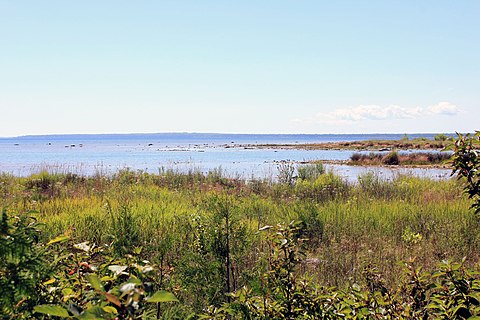
Yearly fluctuations in lake levels alternately kill off vegetation during periods of high water and promote succession during times of low water. Even during times of high water when low-lying plants are inundated, the populations may persist uphill by clonal expansion and spreading their seeds. Lake Michigan has more diverse shoreline vegetation than Lake Ontario, which has a more stable water level due to human intervention. Without the changing lake levels the shoreline would be dominated by woody plants or highly competitive and even invasive water-loving species such as cattails, reed canary grass, or purple loosestrife. Wet meadows like this one thrive when flooding does not occur often enough to allow emergent vegetation to prevail but is still too frequent to allow the establishment of trees and shrubs. [24]
Out of 268 miles (431 km) miles of county shoreline along Lake Michigan and Green Bay surveyed in 2012, 167.5 miles (269.6 km) was vegetated with of high density shrubs and trees. There was also 3.1 miles (5.0 km) of low density shrubs and trees, 29.3 miles (47.2 km) of moderate density shrubs and trees, 32.6 miles (52.5 km) of unmaintained herbaceous vegetation, 31.8 miles (51.2 km) of manicured lawns, and 3.7 miles (6.0 km) with no vegetation. [25]
Some trees have attracted attention:
As of 2019, 243 species of mushrooms and other macrofungi have been identified north of the canal, [36] with 326 species for the county as a whole, including those found in lichens. [37] Several of the more uncommon lichens found in the county are Cetraria arenaria, which grows on the ground, [38] and Anaptychia crinalis, which grows on tree bark. [39]
In 2009, a unique hybrid of Saccharomyces cerevisiae yeast was found on fallen cherries near Fish Creek. This strain of S. cerevisiae descended from both oak-tree and vineyard lineages. [40]
In 1910, Entomophaga maimaiga from Japan was released in Boston in order to infect spongy moths and control their population. [41] In 1996, it was discovered that E. maimaiga had naturally spread to southern Door County. This was the first time it had been detected in the state. [42]

Lake Michigan is one of the five Great Lakes of North America. It is the second-largest of the Great Lakes by volume and the third-largest by surface area, after Lake Superior and Lake Huron. To the east, its basin is conjoined with that of Lake Huron through the 3+1⁄2-mile (5.6-kilometer) wide, 295-foot deep Straits of Mackinac, giving it the same surface elevation as its easterly counterpart; geologically, the two bodies are a single lake that is, by area, the largest freshwater lake in the world.
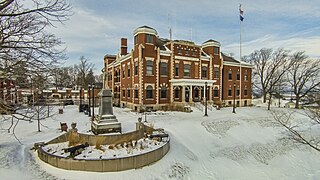
Kewaunee County is a county located in the U.S. state of Wisconsin. As of the 2020 census, the population was 20,563. Its county seat is Kewaunee. The county was created in 1852 and organized in 1859. Its Menominee name is Kewāneh, an archaic name for a species of duck. Kewaunee County is part of the Green Bay, WI Metropolitan Statistical Area as well as the Green Bay-Shawano, WI Combined Statistical Area.

Door County is the easternmost county in the U.S. state of Wisconsin. As of the 2020 census, the population was 30,066. Its county seat is Sturgeon Bay. It is named after the strait between the Door Peninsula and Washington Island. The dangerous passage, known as Death's Door, contains shipwrecks and was known to Native Americans and early French explorers. The county was created in 1851 and organized in 1861. Nicknamed the "Cape Cod of the Midwest," Door County is a popular Upper Midwest vacation destination.
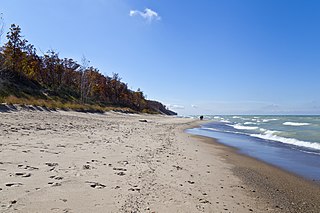
Indiana Dunes National Park is a United States national park located in northwestern Indiana managed by the National Park Service. It was authorized by Congress in 1966 as the Indiana Dunes National Lakeshore and was redesignated as the nation's 61st national park on February 15, 2019. The park runs for about 20 miles (32 km) along the southern shore of Lake Michigan and covers 15,349 acres (6,212 ha). Along the lakefront, the eastern area is roughly the lake shore south to U.S. 12 or U.S. 20 between Michigan City, Indiana, on the east and the Cleveland-Cliffs steel plant on the west. This area's conservation scheme is enhanced by the older Indiana Dunes State Park. To the west of the steel plant lies West Beach and a small extension south of the steel mill continues west along Salt Creek to Indiana 249. The western area is roughly the shoreline south to U.S. 12 between the Burns Ditch west to Broadway in downtown Gary, Indiana. In addition, there are several outlying areas, including Pinhook Bog, in LaPorte County to the east; the Heron Rookery in Porter County, the center of the park; and the Hoosier Prairie State Nature Preserve and the Hobart Prairie Grove, both in Lake County, the western end of the park.
Lake Koshkonong is a reservoir in southern Wisconsin, which was transformed from its original marshland by the construction of the Indianford Dam in 1932. The lake lies along the Rock River, with the river acting as both the primary inflow and the primary outflow for the lake. Lake Koshkonong begins 5.5 mi (8.9 km) downriver from Fort Atkinson, with the large majority of the lake located in southwestern Jefferson County. Small portions of the lake extend into southeastern Dane and northern Rock counties.

The Driftless Area, also known as Bluff Country and the Paleozoic Plateau, is a topographical and cultural region in the Midwestern United States that comprises southwestern Wisconsin, southeastern Minnesota, northeastern Iowa, and the extreme northwestern corner of Illinois. The Driftless Area is a USDA Level III Ecoregion: Ecoregion 52. The Driftless Area takes up a large portion of the Upper Midwest forest–savanna transition. The Blufflands refers to the eastern section of the Driftless area in Minnesota, due to the steep bluffs and cliffs around the river valleys. The western half is known as the Rochester Plateau, which is flatter than the Blufflands. The Coulee Region refers to the southwestern part of the Driftless Area in Wisconsin. It is named for its numerous ravines.

Indiana Dunes State Park is an Indiana State Park located in Porter County, Indiana, United States, 47 miles (75.6 km) east of Chicago. The park is bounded by Lake Michigan to the northwest and is surrounded by as well as within the authorized boundaries of Indiana Dunes National Park, a unit of the National Park Service; the NPS owns the water from the ordinary high water mark to 300 feet (91 m) offshore. The 1,530-acre (619.2 ha) Dunes Nature Preserve makes up the bulk of eastern part of the park, and includes most of the park's hiking trails and dune landscape. This was one of the first places Richard Lieber considered when establishing the Indiana State Park system. Like all Indiana state parks, there is a fee for entrance. Indiana Dunes State Park was established in 1925 and designated a National Natural Landmark in 1974.

Chambers Island, named in honor of Col. Talbot Chambers, is a 2,834 acre island in Green Bay, about 7 miles (11 km) off the coast of the Door Peninsula, near Gibraltar, Wisconsin. It is part of the Town of Gibraltar in Door County.
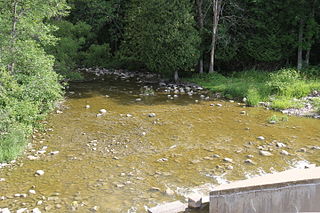
The Ahnapee River is a 14.7-mile-long (23.7 km) river on the Door Peninsula in eastern Wisconsin in the United States. It rises in Door County, Wisconsin, and flows through Kewaunee County into Lake Michigan at the city of Algoma. Its name has been ascribed as coming from the Ojibwe word aanapii meaning "when?".

State Trunk Highway 42 is a state highway in the U.S. state of Wisconsin. It runs for 135 miles (217 km) north–south in northeast Wisconsin from Sheboygan to the ferry dock in Northport. Much of the highway is part of the Lake Michigan Circle Tour from the eastern junction with U.S. Highway 10 (US 10) in Manitowoc to its junction with WIS 57 in Sister Bay. WIS 42 parallels I-43 from Sheboygan to Manitowoc, and parallels WIS 57 throughout much of the route, particularly from Manitowoc to Sturgeon Bay, meeting the northern terminus of WIS 57 in Sister Bay.

Rock Island is a mostly wooded island off the tip of Wisconsin's Door Peninsula at the mouth of Green Bay, in Door County, Wisconsin. The 974.87-acre (394.5 ha) island is approximately 1.6 miles (2.6 km) long and 1.1 miles (1.8 km) wide. It rises to 65 meters above Lake Michigan, making it the highest in elevation out of all the Potawatomi Islands. It is almost entirely owned by the Wisconsin Department of Natural Resources, which maintains Rock Island State Park. It is the northernmost part of the town of Washington.

Sandy Island Beach State Park is a New York State park on the eastern shore of Lake Ontario. Its highlight is a 1,500-foot (460 m) natural sandy beach. The park is near the southern end of a notable 17-mile (27 km) length of sandy shoreline, coastal dunes, and wetlands ; a 1959 study noted that "The eastern end of Lake Ontario contains not only the finest beaches on the entire lake but also the finest wildlife habitat."
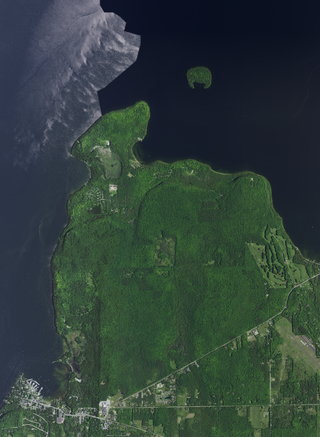
Peninsula State Park is a 3,776-acre (1,528 ha) Wisconsin state park with eight miles (13 km) of Green Bay shoreline in Door County. Peninsula is the third largest state park in Wisconsin and is visited by an estimated one million visitors annually.

Whitefish Dunes State Park is a 867-acre (351 ha) state park of Wisconsin on the eastern shore of the Door Peninsula. This day-use park preserves the most substantial sand dunes on the western shore of Lake Michigan. The remains of eight successive prehistoric Native American villages are on the National Register of Historic Places as Whitefish Dunes-Bay View Site. Cave Point County Park is an enclave inside the state park, allowing visitors free foot access to the state park by the shoreline trail connecting the parks.
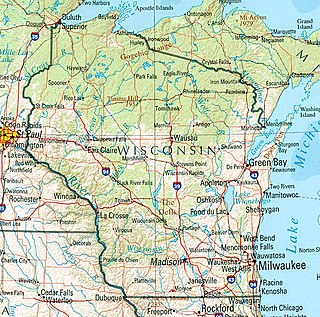
Wisconsin, a state in the Midwestern United States, has a vast and diverse geography famous for its landforms created by glaciers during the Wisconsin glaciation 17,000 years ago. The state can be generally divided into five geographic regions—Lake Superior Lowland, Northern Highland, Central Plain, Eastern Ridges & Lowlands, and Western Upland. The southwestern part of the state, which was not covered by glaciers during the most recent ice age, is known as the Driftless Area. The Wisconsin glaciation formed the Wisconsin Dells, Devil's Lake, and the Baraboo Range. A number of areas are protected in the state, including Devil's Lake State Park, the Apostle Islands National Lakeshore, and the Chequamegon–Nicolet National Forest.
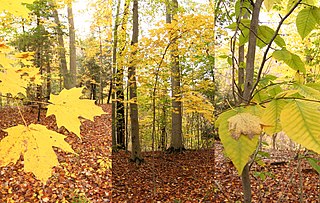
A beech–maple forest or a maple beech forest is a climax mesic closed canopy hardwood forest. It is primarily composed of American beech and sugar maple trees which co-dominate the forest and which are the pinnacle of plant succession in their range. A form of this forest was the most common forest type in the Northeastern United States when it was settled by Europeans and remains widespread but scattered today.

Castle Rock Lake is an artificial lake on the Wisconsin River. It is located in central Wisconsin in Adams County and Juneau County. The lake has an inflow from Petenwell Lake, Yellow River, Big Roche a Cri., and Klien Creek. It has a surface area of 16,640 acres (67.3 km2) and its depth varies from 8–20 ft (2.4–6.1 m) in most places, with area in the old river beds reaching as deep as 35 ft (11 m).

Trout Lake is in Vilas County, Wisconsin, near the towns of Boulder Junction and Arbor Vitae, Wisconsin. With a surface area of 6.208 sq mi (16.079 km2) and a volume of 0.058 cu mi (0.240 km3), Trout Lake is one of the largest lakes in Vilas County. It has 16.1 mi (25.9 km) of shoreline, a large portion of which is undeveloped. There are also seven islands within the lake: Miller Island, Zimmerman Island, Haunted Island, Easter Island, Fisk Island, Chocolate Drop Island, and an unnamed island. It is a dimictic oligotrophic lake that supports a large number of sport fish, which has made it a popular angling destination.

The climate of Door County, Wisconsin is tempered by Green Bay and Lake Michigan. There are fewer extremely cold days and fewer hot days than in areas of Wisconsin directly to the west. Lake waters delay the coming of spring as well as extend mild temperatures in the fall. Annual precipitation is slightly lower than elsewhere in northern Wisconsin. The county features a humid continental climate with warm summers and cold snowy winters.
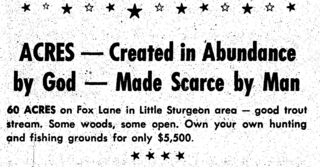
The economy of Door County is similar to that of Bayfield, Iron, Oneida, Sawyer, and Vilas counties. These six northern Wisconsin counties have been categorized as having "forestry-related tourism"-based economies.